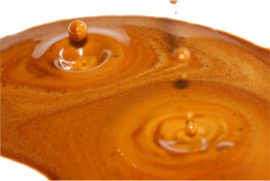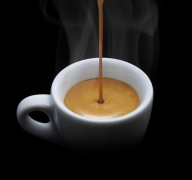How to correctly identify the main points of espresso?
"Espresso" is known as the "soul of coffee", but it should not be translated as "espresso" in Chinese, because in addition, there is a stronger coffee that needs to be used. For cafes, "a coffee shop that does not sell 'Espresso' is not a coffee shop", which shows the importance of "Espresso".
Now "Espresso" has almost become a representative symbol of Italy, so it seems more natural for Italy to define "Espresso".
So what is "Espresso"?
Comprehensive coffee beans roasted at a depth of 7-8 grams are ground into very fine coffee powder. after 9 atmospheric pressure and high temperature hot water of about 92 degrees Celsius, 30 milliliters of strong coffee liquid is rapidly extracted in a short time of 15 seconds called "Espresso".
Espresso is a technological way of making coffee. According to the definition of "EspressoCoffee The Chemistry of Quality", it must meet the following conditions:
The weight of coffee powder (one cup) 6.5 ±1.58g
Temperature of water (℃) 90 °±5 °
Water pressure 9 ±2 Atmospheric pressure (bar)
Filtration time 30 ±5 seconds
The temperature of water
If the water temperature is too low, it will cause insufficient extraction, and the substances inside the coffee can not be fully released, so that you can only cook a cup of Espresso; with insufficient flavor and sour taste. Once the water temperature is too high, excessive extraction will make the coffee bitter and astringent.
The pressure of water
The general hot water brewing method can only extract water-soluble substances in coffee, while Espresso can further extract water-insoluble substances under high pressure. These high pressures will completely emulsify the lipids (Lipophilic Substances) inside the coffee and dissolve into the water, which is the main source of "mellow taste" (body).
Emulsification will make Espresso taste thicker, making people drink with a "velvety" feeling; and stickiness will form a lower surface tension, more able to invade the taste buds, so that mellow reverberate in the mouth for a long time.
Filter time
The length of filtration time will affect the amount of water output. Espresso uses high-pressure hot water to extract the flavor of the coffee, which takes about 25 seconds to complete the task (after this time, the liquid is no longer tasty and will only dilute the Espresso). After the timeout, some people continue to let it out of the water and fill a cup to form a "Americano" or "Lungo", which tastes like charcoal-roasted coffee.
The most important thing about a successful "Espresso" is to see if there is a thick layer of brown-red grease foam floating on the surface: "Crema Cleima".
The most important feature of "Espresso" is the cohesion of fragrance and taste. The general orthodox way to drink is to drink it in one sip while waiting for the coffee to come out. While enjoying the fragrant taste, caffeine intake is greatly reduced. This drinking method, which takes the taste of coffee to the extreme but takes care of health, has made coffee experts around the world recognize that "Espresso" is worthy of the soul of coffee.
Espresso is Italian, meaning "under pressure", which reflects the importance of stress in the production of espresso. In the eyes of those who play with coffee, Espresso is no longer a simple "espresso". It is a kind of comprehensive coffee, a method of roasting, a kind of coffee brewing, a kind of cooking, but also a kind of life.

Important Notice :
前街咖啡 FrontStreet Coffee has moved to new addredd:
FrontStreet Coffee Address: 315,Donghua East Road,GuangZhou
Tel:020 38364473
- Prev

Common mistakes in espresso espresso
Common mistakes: excessive extraction of coffee powder; too fine powder; too high temperature. After coffee extraction, the coffee cup is too cold; the handle temperature is not enough; the coffee powder is too fine; the extraction is insufficient. Insufficient extraction, single color, insufficient concentration, insufficient coffee; coffee powder is too coarse; pressure is too low; coffee machine temperature is not enough. The coffee cup precipitates too much after drinking and the water pressure is too high.
- Next

There are five secrets to running a good social media cafe.
Perseverance many coffee shops have their own social media accounts, but few people can persevere. You must insist on sending fresh articles or information regularly, or your account will die chronically. Fans will gradually lose patience, and some may even unsubscribe as a result. It may sound simple to be persistent, but with the increasing variety of social networks, I want to
Related
- The milk tea cup becomes smaller?! Overlord Tea Girl launches a new "Return to Yunnan" series
- Accused of selling counterfeit and high-priced coffee beans! Well-known boutique coffee brand "Oukelao" bowed and apologized!
- How to make espresso dumplings? Can I eat coffee and glutinous rice balls together?
- Save the unformed and stagnant powder cakes in one second! What is the problem with stagnant water in the powder bowl of the espresso machine?
- What does hand-brewed coffee stop mean? Why is it not recommended to make coffee by hand?
- Is it normal to smell like coffee? Why does coffee smell like alcohol? What's wrong with the strong smell of cold extract ice dripping ice brewed coffee?
- How to solve the problem that hand-brewed coffee extraction takes too long? Why is the water flowing so slowly when making coffee?
- The main points of making Australian white coffee, the proportion details, how does Australian white properly foam and blend the flowers?
- Can ice water make cold extract coffee? What is the difference between room temperature water and ice water for making cold coffee?
- What milk is best for making latte and white Dirty coffee? What is the difference between different brands of fresh milk and pure milk for making coffee?

